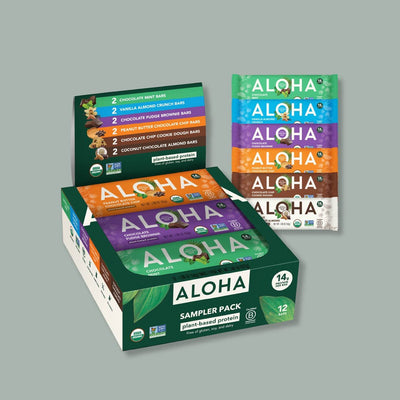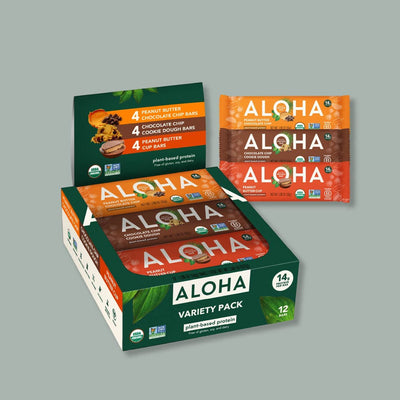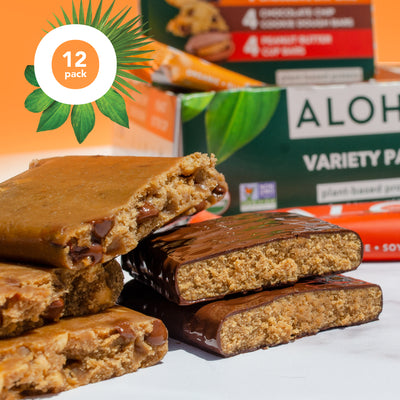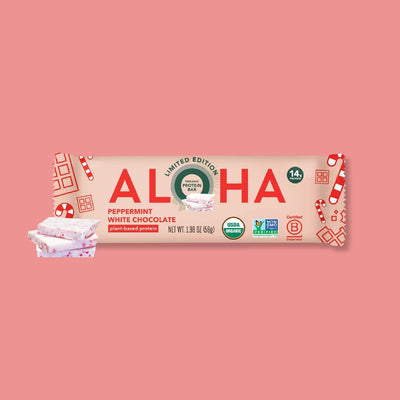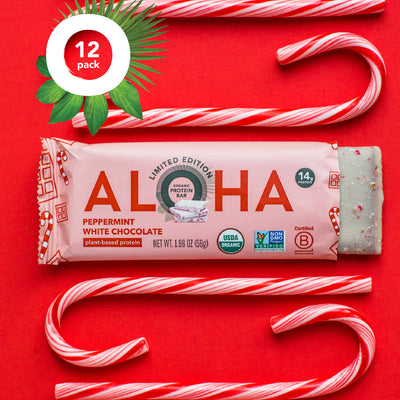Key Takeaways:
- Different Strengths, Same Goal: In the pea protein vs soy protein debate, pea shines for neutral taste and versatility; soy is naturally “complete.” Your winner depends on goals and preferences.
- Label Literacy Helps: Check protein per scoop, ingredient length, certifications, and allergens to compare soy vs pea protein options quickly.
-
Use-Case First: Choose the powder that fits how you actually eat—shakes, bowls, or baking—so your pick becomes a daily habit.
If you’re torn between pea vs soy protein, the right answer is the one you’ll use every day. At ALOHA, we craft soy-free, USDA Organic, Non-GMO Project Verified, Certified Vegan protein options, great for anyone who prefers to avoid soy while keeping nutrition and taste front and center.
Below, we’ll compare nutrition, amino acids, mixability, allergens, and use cases so you can decide with confidence.
What Does “Best” Mean For You?
“Best” is goal-specific. If you prioritize a neutral flavor that disappears in smoothies or baking, pea often wins. If you want a naturally complete amino acid profile from a single plant source, soy fits the brief. For a refresher on protein basics and why distribution matters across your day, see all about protein.
Nutrition Snapshot: Protein, Aminos, And Labels
Think of this section as label literacy for the pea protein vs soy protein decision. Most tubs land around 15–25g protein per scoop, but the fine print matters: soy is naturally “complete” (all nine essential amino acids in adequate amounts), while pea is slightly lower in methionine, easy to
round out by pairing with grains or seeds across your day. Scan ingredient length and clarity, sweetener type, sodium and fiber levels, and any added gums or flavors.
Certifications (USDA Organic, Non-GMO Project Verified, Certified Vegan) and clear allergen statements are helpful tie-breakers—especially if you prefer soy-free. Since taste and mixability vary by brand, choose the cleanest label that also fits your routine; a powder you enjoy and use consistently will outperform a “perfect” one that gathers dust.
Protein Per Scoop
Both pea and soy powders typically deliver ~15–25g per serving, depending on brand and formulation. Focus on your target per meal and how the powder fits into breakfast, lunch, or post-workout.
Amino Acids & “Complete”
Soy is naturally a “complete” protein, meaning it contains adequate amounts of all nine essential amino acids. Pea is strong but slightly lower in methionine—easily covered by pairing with grains or seeds. If you want a quick primer on the term, read what is a complete protein.
Certifications & Ingredients
Scan for short, recognizable ingredient lists and third-party standards you value (USDA Organic, Non-GMO Project Verified, Certified Vegan). If you avoid soy, pick explicitly soy-free blends like ALOHA.
Taste, Texture, And Mixability
In everyday shakes, pea’s neutral flavor and creamy body make it a favorite for many beginners. Soy can be equally smooth, but flavor notes vary by brand and sweetener system. Test your pick in the format you’ll use most, blended with plant milk and frozen fruit, or whisked into warm oats, so the soy vs pea protein choice fits your routine from day one.
Digestibility, Allergens, And Preferences
Soy is a common allergen; pea generally isn’t, though tolerances vary by person. If you’re exploring plant-forward eating more broadly—and wondering where dairy fits—this short explainer answers does vegan mean dairy free so labels are crystal clear. Start with half servings if you’re sensitive, and adjust based on how you feel.
Sustainability And Sourcing
Both pea and soy are widely used, efficient protein crops; brand practices around sourcing and certifications can be the bigger differentiator. As an employee-owned Certified B Corp/PBC, ALOHA centers transparent sourcing and community impact while delivering great taste and convenience.
Cooking And Baking: How They Behave In Heat
When you take pea protein vs soy protein into the kitchen, heat reveals differences. Pea’s neutral flavor and moderate water absorption make it easy to fold into pancakes, waffles, muffins, and even creamy soups without taking over. Soy can brown nicely in baked goods and scrambles thanks to its amino profile, but flavor notes vary by brand—test a half batch to dial sweetness and liquids. As a rule of thumb, swap 10–20% of flour with powder and add a splash of liquid to keep batters silky.
Flavor Pairings That Make Each Shine
In the soy vs pea protein taste test, pairings matter. Pea loves cocoa, banana, berries, espresso, cinnamon, and vanilla, flavors that highlight its creamy neutrality in shakes and oats. Soy plays well with bolder profiles like peanut butter, maple, chai spices, and savory applications (tofu-style scrambles, sauces). Match the powder to the flavors you already crave so your choice becomes a habit, not a hurdle.
Budget And Value: Getting The Most Per Scoop
Price-per-serving can vary widely in the pea vs soy protein aisle, so compare labels by cost per scoop, grams of protein, and how often you’ll realistically use it. A powder that mixes well in smoothies, oats, and batters delivers more value than one you only tolerate in a single recipe. Certifications, clean ingredients, and allergen fit are smart tie-breakers—choose the one that keeps you consistent without stretching your budget.
One-Week Tryout To Make Your Decision
Turn “I’m not sure” into data. For seven days, rotate both powders through real use cases: smoothies on days 1–2, warm oats on days 3–4, baked or pancake test on day 5, a savory application on day 6, then reflect on taste, texture, and how you felt on day 7. The winner of pea protein vs soy protein is the tub you reached for without thinking—because the best choice is the one you’ll use every day.
Certifications & Label Clarity: Read Beyond The Front
Front-of-tub claims can blur the real differences in pea protein vs soy protein, so scan the facts panel. Prioritize short, recognizable ingredient lists; protein per serving (aim ~15–25g); and sweetener type and amount. Look for third-party marks that match your values—USDA Organic, Non-GMO Project Verified, and Certified Vegan—and check allergen statements if you avoid soy. Note sodium and fiber levels, plus any added gums or flavors, so you know how a scoop will taste and mix in smoothies, oats, or batters. Transparent sourcing and clear certifications make comparison simple—and help you choose the powder you’ll actually use every day.
Use Cases: When Pea Wins Vs When Soy Wins
Choose the powder that fits how you actually eat, then let habits pick the winner. Pea wins when you want a neutral, creamy base that disappears into smoothies, warm oats, pancakes, or sauces; it’s also the go-to for soy-free households and for anyone prioritizing simple labels and easy mixability in the pea protein vs soy protein debate. Soy wins when you want a single-source, naturally complete protein and you tolerate soy well; it can be a strong choice for post-workout shakes, savory scrambles, or baking when you’re chasing maximum amino coverage with one scoop. If you’re still torn on soy vs pea protein, test each in your real use case (one smoothie and one oatmeal bowl) and keep the one you’ll reach for every day—consistency beats theory.
When Pea Wins
You want a neutral base for smoothies, oats, pancakes, or sauces; you prefer soy-free; or you plan to pair with grains/seeds in meals. Pea’s mild profile makes it easy to hit goals without strong flavor notes—ideal for daily blends.
When Soy Wins
You want a single-source, naturally complete option and you tolerate soy well. Soy’s amino profile and wide availability can be attractive if you’re set on one scoop doing all the heavy lifting.
How Pea And Soy Compare To Whey
Curious how these plant picks stack up against dairy? Start with plant-based protein vs whey for a broad overview, then get granular with pea protein vs whey if pea is your front-runner. Use taste, texture, and routine fit as your final tie-breakers.
How To Choose In Three Steps
Define your top priority: taste, clean label, soy-free, or a single-source complete protein. Shortlist two powders that meet that priority and your budget. Test both in your real use case (one smoothie and one oatmeal bowl), then pick the one you’ll reach for every day. This trims the pea vs soy protein decision to a simple, repeatable process.
Final Thoughts
In the pea protein vs soy protein matchup, there’s no universal champion—only the best fit for your taste, goals, and pantry. Pea excels at neutrality and versatility (especially if you prefer soy-free). Soy offers natural completeness and broad availability. Choose the powder you’ll use consistently, and let the habit, not the hype, deliver results.
Read Also:
- Clean Protein Power 101: All Your Questions Answered
- Fresh Protein Bars Explained: ALOHA’s Secrets Revealed
- Is Whey A Complete Protein? Your Burning Questions Answered
Frequently Asked Questions About Pea And Soy Protein
Is pea or soy better if I’m brand new to plant protein?
Start with the powder that fits your routine and palate. Many beginners like pea for its neutral flavor and easy mixing in smoothies and oats. If you tolerate soy and want a naturally complete option, soy can be a solid first pick. Test both in your favorite format and choose the one you’ll actually use.
What does “complete protein” mean in plain English?
A complete protein contains all nine essential amino acids in adequate amounts. Soy is naturally complete; pea comes close and is easily complemented by grains or seeds across your day. If you want a short primer, the article what is a complete protein breaks it down clearly. The overall day’s diet matters more than any single scoop.
Which one tastes better in shakes—pea or soy?
Taste varies by brand, sweetener, and flavor, but pea often reads more neutral and creamy in blended drinks. Soy can be just as smooth, with slightly different notes. Try each with your usual plant milk and frozen fruit to see which you prefer. Your “best” is the one that disappears into your morning routine.
Will either upset my stomach?
Most people do well with either, but sensitivities are individual. Soy is a common allergen, so check labels if that applies to you. If you’re unsure, start with half a serving and build up while monitoring how you feel. Hydration and thorough blending also help.
Can I bake with pea or soy protein?
Yes. Both work in pancakes, waffles, muffins, and energy bites with small adjustments to liquid. Pea’s neutrality often makes it easier to use without changing flavor. Mix thoroughly and test a half batch to dial in texture.
How much protein per serving should I look for?
Many people aim for 15–20 grams per scoop, depending on size and activity level. It’s more important to distribute protein across meals than to chase a huge serving at once. For context and simple benchmarks, see all about protein linked above. Consistency wins.
Is soy protein safe if I’m trying to avoid dairy?
Yes, soy is dairy-free. If label language ever confuses you, this explainer, does vegan mean dairy free, clarifies the terms and where they overlap. If you prefer to avoid soy altogether, choose a certified soy-free pea blend like ALOHA.
How do pea and soy compare to whey for results?
Whey and plant proteins can both support everyday nutrition and active routines; the choice often comes down to taste, digestion, and values. For a broad overview, see plant-based protein vs whey, and for a pea-specific comparison, check pea protein vs whey. Pick what you’ll use reliably.
What certifications should I prioritize?
Look for third-party standards that matter to you: USDA Organic, Non-GMO Project Verified, Certified Vegan, and clear allergen statements. Transparent sourcing and brand values can be tie-breakers. ALOHA’s employee-owned, Certified B Corp/PBC status reflects broader commitments beyond the tub.
How do I make the final call between pea vs soy protein?
List your top priority, shortlist two options, and run a taste test in your real breakfast or post-workout routine. The powder you enjoy most—and can see yourself using daily—is your winner. If you’re still split, alternate for a week and track how you feel; your habits will pick the champion for you.





